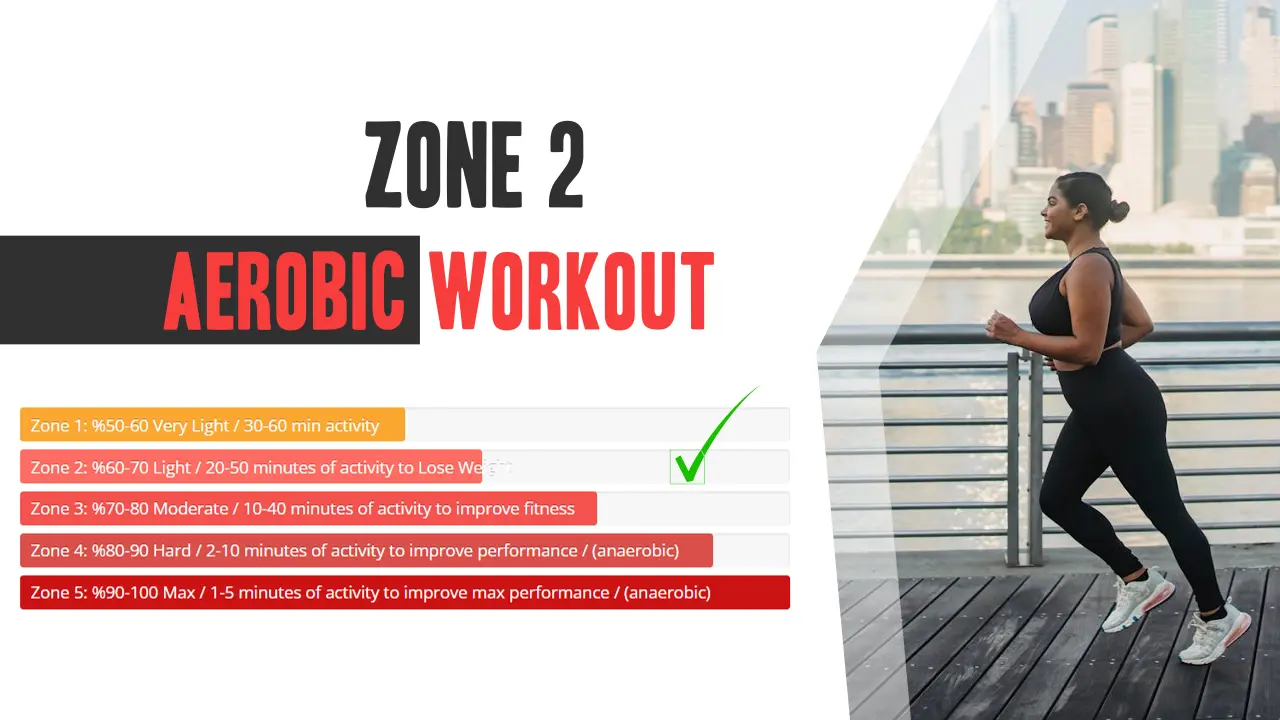The cardio of zone 2 refers to Aerobic exercise of low to moderate intensity played at a heart rate where your body burns mainly fat for fuel. Zone 2 cardio builds the aerobic foundation necessary for a Long and healthy life– without overloading your body. This is part of a 5 -zones system used to measure the intensity of the exercise based on heart rate and oxygen consumption.
Why is it called “Zone 2”
Zone 2 is often called “fat combustion zoneBecause it maximizes the use of fats as a fuel source while keeping the lasting effort.
The intensity of the exercise is generally divided into five zones:
In zone 2, you train yourself 60 to 70% of your maximum heart rate. You can hold a conversation, your breathing is stable and it seems durable for long periods – think fast walking, running, bike or slow rowing.
The science behind zone 2: why it works
1. Oxidation of fat
The formation of zone 2 increases Mitochondrial densityallowing your muscles to burn more fat for energy at rest and during exercise (Holloszy and Booth, 1976).
2. Mitochondrial health
Mitochondria are your body’s energy factories. Zone 2 promotes Mitochondrial biogenesisImproved endurance and delaying age -related decline (Lanza et al., 2008).
3. Improvement of vo₂ max
VO₂ Max – A key predictor of longevity – improves coherent aerobic training. Even moderate increases reduce the risk of cardiovascular mortality and all causes combined (Kodama et al., 2009).
4. Insulin sensitivity and fat loss
Zone 2 improves Glucose absorption And Insulin sensitivityThis makes it an ideal tool to manage body fat and prevent type 2 diabetes (Reichkendler et al., 2010).
Cardio and zone 2 longevity
Regular aerobic training – especially in zone 2 – has been demonstrated at:
- Reduce risk of cardiovascular disease
- Improve Vo₂ maxA key predictor of lifespan
- Support mitochondrial functionage
- Lower Chronic inflammation and oxidative stress
Studies show a strong link between Fitness and cardiorespiratory life. A 2018 Jama Study by Mandesager et al. found that higher fitness levels (measured via VO₂ max) were associated with lower mortality rateRegardless of age, sex or comorbidities.
Zone 2 vs HIIT: Who burns more fat?
Zone 2 mainly uses fat for fuelWhile Hiit uses carbohydrates. Hiit quickly burns more calories, but increases cortisol and fatigue. Although it is not as intense as Hiit, zone 2 improves Aerobic capacity Over time. A stronger base supports better performance in all other areas.
When to choose zone 2 vs hit
| Aim | Best training |
|---|---|
| Fatty adaptation | Zone 2 |
| Quick results | Hit |
| Hormonal balance | Zone 2 |
| Vo₂ max boost | The two combined |
| Recovery and sustainability | Zone 2 |
How to find your heart rate in zone 2
Use the maximum heart rate formula (220 – age)
The easiest way to estimate zone 2 is to use:
Zone 2 HR = 60–70% of HR max
Max HR ≈ 220 – Your age
Example: For a 40 year old man:
- Max HR = 180
- Zone 2 = 108 to 126 BPM
Try the discussion test or the RPE method
- You should be able to speak in complete sentences.
- The perceived effort rate (RPE) should be 4–5 out of 10.
Example of a weekly training plan Zone 2
Weekly preview
| Day | Activity | Duration | Target in the HR zone | Notes |
|---|---|---|---|---|
| Monday | 12-3-30 Training on treadmill | 30 min | 60–65% HRMAX | Big start to the week; can be low impact |
| Tuesday | Strength training + light cycling | 20–30 min (cardio) | 60–70% HRMAX | Associate yourself with weights; Easy post-lift wrinkle |
| Wednesday | Zone 2 jog or bike ride | 60 min | 65–70% HRMAX | Maintain a constant rhythm |
| THURSDAY | Rest or Mobility light promenade | 30–45 min (optional) | Zone 1–2 | Recovery session or optional walking |
| Friday | Airon, elliptical or swimming | 60–75 min | 60–70% HRMAX | Cross -transformation to reduce joint stress |
| SATURDAY | Force training and long hiking | 20–30 min | 60–70% HRMAX | Better to strengthen strength |
| Sunday | Rest or zone 2 session optional Vive walking walking | 30 min | 60–65% HRMAX | Optional; Ideal for active recovery |
How to personalize this plan
For beginners
- Start with sessions from 30 to 45 minutes, 3 days / week
- Keep intensity at the lower end (60–65% HRMAX)
- Use a fast walk, the elliptical or the bicycle to stay friendly
- Gradually add 5 to 10 minutes per session per week
For intermediary / advanced
- Use longer weekend sessions (30–60 + min) to stimulate endurance
- Increase at 4 to 5 + zone 2 sessions per week
- Mix the modalities: bike, race, rowing, swimming
- Add occasional fasting sessions (for advanced fat adaptation)
How to adapt to fitness level
- Beginners: Start with 30 minutes, 2 to 3 times / week
- Intermediate: Aim 3 to 4 hours / week
- Endurance athletes: Up to more than 6 hours of zone 2 each week
Who should prioritize zone 2?
- Beginners: Low impact entry into fitness
- Endurance athletes: Build an aerobic base
- Older adults: Supports the health of the heart, the brain and the joints
- Overweight: AIDS in fat loss and insulin sensitivity
- Burned pushes: Improves recovery and hormonal balance
Current errors to avoid
- Too hard training: If you are out of breath or you cannot speak, you have left zone 2.. This is beating the goal.
- Ignore monitoring of heart rate: It is difficult to “feel” zone 2 without a monitor, especially if you are in good shape.
- Wait for quick results without patience: Fat loss and maximum improvements weeks to monthnot days. But the results are durable and deeply rooted.
FAQ on the formation of zone 2
Can I walk in zone 2?
Yes! For beginners or the elderly, a fast walk may be sufficient to stay in zone 2.
How long should I stay in zone 2?
The sessions should last at least 30 minutesIdeally 45 to 90 minutes for optimal advantages.
Is zone 2 sufficient for fat loss?
Yes, especially when combined with good nutrition. You can lose fat without HIIT if zone 2 is carried out consistently.
Do I need a heart rate monitor?
It is highly recommended. The optical monitors (based on the wrist) are correct, but the chest straps are more precise.
Final reflections
The area 2 cardio is one of the most powerful, proven and neglected forms of training. It supports fat loss, cell health, cardiovascular endurance and longevity, while being low impact and durable.
Instead of always continuing the intensity, try to build consistency with zone 2. Over time, you will notice:
- More energy
- Best endurance
- Easier fat loss
- Improvement in blood sugar
- Long -term health gains
References
- Holloszy, Jo and Booth, FW (1976). Biochemical adaptations to the muscle endurance exercise. Annual physiology review.
- Lanza, Ir, et al. (2008). Endurance exercise as a counter-measure for aging. Aging cell.
- Kodama, S., et al. (2009). Cardiorepiratory fitness as a quantitative predictor of all causes mortality. Jama.
- Mandesager, K., et al. (2018). Association of the cardiorepiratory condition with long -term mortality. Jama Network Open.
- Reichkendler, MH, et al. (2010). The effect of exercise on insulin sensitivity and fat distribution. Diabetes.
- Brooks, GA and Fahey, TD (2004). Physiology of exercise: human bioenergetics and its applications.






